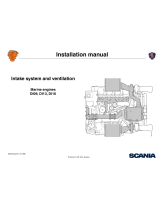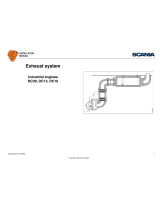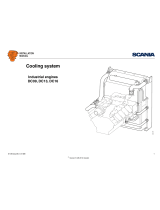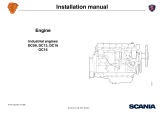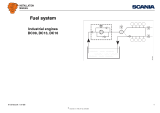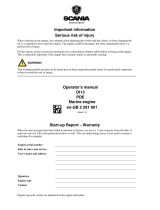Page is loading ...

01:02 Issue 10 en-GB
© Scania CV AB 2018, Sweden
Installation manual
Intake system and ventilation
Industrial engines
DC09, DC13, DC16
OC16

INSTALLATION
MANUAL
© Scania CV AB 2018, Sweden
01:02 Issue 10 en-GB 2
Changes from the previous issue............................................................................3
Intake air .................................................................................................................. 4
Intake air taken from outside engine room.......................................................... 5
Intake air taken from engine room ...................................................................... 8
Ventilation requirements for gas engines..............................................................9
Air cleaner..............................................................................................................10
Air cleaners with precleaner.............................................................................. 11
Air cleaners without precleaner......................................................................... 12
Crankcase ventilation............................................................................................13
Open crankcase ventilation ............................................................................... 13
Closed crankcase ventilation............................................................................. 14
Connection to turbocharger .................................................................................15
Cleanliness requirements................................................................................... 15
Charge air pipe .................................................................................................. 15
Stage IV/Tier 4f engines ................................................................................... 16
Important data.......................................................................................................20

INSTALLATION
MANUAL
© Scania CV AB 2018, Sweden
Changes from the previous issue
01:02 Issue 10 en-GB 3
Changes from the previous issue
The changes made in this document compared with the previous issue are marked
with a line in the left-hand margin. The changes are also described below.
• Max. permissible vacuum in the intake system has been changed to 40 mbar for
16 litre single-speed engines. See Intake air taken from outside engine room
.
• Max. permissible vacuum in the engine compartment for engines without fan
(1 mbar) has been removed. 2 mbar now applies to all engines. See Intake air tak-
en from engine room.
• Safety cartridges are no longer included with air cleaners with precleaners. Safety
cartridges can instead be purchased as an option. See Air cleaner
.
• Clearances for Air cleaners with precleaner
and Air cleaners without precleaner
have been corrected.
• Section Important data
has been added.

INSTALLATION
MANUAL
© Scania CV AB 2018, Sweden
Intake air
01:02 Issue 10 en-GB 4
Intake air
If the intake line is located close to exhaust pipes or other hot parts, radiation protec-
tion should be used to limit unnecessary heating of the intake air.
REQUIREMENT!
The intake air temperature may not exceed the ambient temperature by more than
5°C for Stage IV/Tier 4f engines, or 10°C for other engines.
Measure the temperature when the installation is complete. Refer to 01:08 Measur-
ing instructions for installation inspection.
If the intake air temperature upstream of the turbocharger continuously exceeds
30°C, then engine power may drop. If the engine is enclosed in some manner, make
sure that there is an adequate flow of intake air.
The dependence of the engine power on intake air temperature is shown in the chart
on the right. This diagram is only valid for DC engines. 100% engine power is shown
under actual test conditions at the factory.
Gas engines can be subject to significant power loss if the intake air to the turbo-
charger has a high temperature in combination with the fuel having a low MN value
(knock-sensitive fuel).
The engine air consumption in kg/min at full power and at different engine speeds is
indicated in the tables showing the air consumption and radiated heat for the relevant
engine type in 01:06 Technical data.
100
95
90
%
A
B
10 20 30
25
40 50
°C
340 422
Engine power dependence on intake air temperature. 100 % at 25°C, 1,000 mbar, en-
gine power setting not corrected.
This diagram is only valid for DC engines.
A = Engine power.
B = Intake air temperature.

INSTALLATION
MANUAL
© Scania CV AB 2018, Sweden
Intake air
01:02 Issue 10 en-GB 5
Intake air taken from outside engine room
In engine systems where the engine intake air comes from outside the engine room
and is led via a fresh air line to the engine, the vacuum for the intake system should
be measured.
The air intake should be located so that the intake air is as clean as possible and so
that neither the engine exhaust gases nor heated air from the engine room can mix
with the intake air. The air intake should be designed to exclude water, snow and con-
tamination.
The intake air must not contain chemical pollutants, such as CFCs.
REQUIREMENT!
The maximum permissible vacuum in the intake system is 30 mbar. For 16 litre sin-
gle-speed engines, a vacuum of 40 mbar is permissible. This value includes the vac-
uum in the new air filter, connected coarse filter and in the fresh air line.
Measure the vacuum when the installation is complete. Refer to 01:08 Measuring in-
structions for installation inspection.

INSTALLATION
MANUAL
© Scania CV AB 2018, Sweden
Intake air
01:02 Issue 10 en-GB 6
The following applies to the fresh air line:
• The fresh air line must not be routed with any sharp bends.
• The inside of the fresh air line must be flat and even.
• If a hose is used as a fresh air line, it must be rigid enough that it does not collapse
onto itself.
It is not necessary to check the vacuum in the following cases:
• If the intake system is comprised of air hoses and air pipes from Scania's standard
range.
• If the fresh air line is maximum 5 m and has an inside diameter of at least 160 mm
for DC09 or 210 mm for DC13 and DC16, respectively.
If the planned fresh air line is longer than 5 m, the required diameter must be calcu-
lated as illustrated. The vacuum upstream of the turbocharger must then be measured.
Refer to 01:08 Measuring instructions for installation inspection.
REQUIREMENT!
The total vacuum in the intake system with a blocked air filter must not exceed
65 mbar.
Engine damage will not occur up to 100 mbar, but fuel consumption and smoke will
increase. Above 100 mbar there is a risk that the air volume to the engine will be in-
adequate, resulting in breakdowns.
B (kg/min)
365 744
A (mm)
500
400
300
200
100
0
0
10 20 30 40 50 60
25 m
50 m
Calculation of minimum diameter of the intake line.
A = Intake line diameter.
B = Air consumption.

INSTALLATION
MANUAL
© Scania CV AB 2018, Sweden
Intake air
01:02 Issue 10 en-GB 7
Ventilation of the engine room with fresh air line to the engine
If the intake air to the engine is taken from outside the engine room, it is important
to check that the temperature in the engine room does not get too high.
REQUIREMENT!
The temperature in the engine compartment must not exceed 90 °C.
Measure the temperature when the installation is complete. Refer to 01:08 Measur-
ing instructions for installation inspection.
If the temperature exceeds 90°C, there is a risk of malfunction in the engine electrical
components and engine control unit. If there is a risk that the temperature will exceed
this value, the engine room must be ventilated.
When dimensioning the engine room ventilation, other air consumers in the engine
room must also be considered. The amount of radiated heat emitted by the various
engines is indicated in 01:06 Technical data.
The exhaust pipes should be insulated to reduce the radiated heat in the engine room.
See 01:04 Exhaust system.

INSTALLATION
MANUAL
© Scania CV AB 2018, Sweden
Intake air
01:02 Issue 10 en-GB 8
Intake air taken from engine room
When the engine intake air is taken from the engine room, the air intake must be lo-
cated in the engine room. The opening area should be large enough to ensure that no
vacuum arises in the engine room. The air intake should also be designed and posi-
tioned so that it cannot be closed or accidentally blocked by water, snow or contam-
inants.
The air intake should be located so that the intake air is as clean as possible and so
that neither the engine exhaust gases nor heated air from the engine room can mix
with the intake air to the engine.
In the chart on the right-hand side, the recommended minimum area for the air intake
can be read from the engine air consumption.
If several engines or other air consumers are located in the same engine room, the
diameter should be increased correspondingly.
REQUIREMENT!
The vacuum in the engine compartment must not exceed 2 mbar.
Measure the vacuum when the installation is complete. Refer to 01:08 Measuring in-
structions for installation inspection.
10
0,1 0,2 0,3 0,4
20
30
40
50
60
kg/min
m
2
25
o
C
340 420
Calculation of minimum air intake area.

INSTALLATION
MANUAL
© Scania CV AB 2018, Sweden
Ventilation requirements for gas engines
01:02 Issue 10 en-GB 9
For installations where the engine draws the intake air directly from the engine room,
the engine room must normally be equipped with a ventilation system. This system
should extract the air heated by radiation etc. in order for the requirement of a low
intake air temperature to be met.
If there is a refrigerator compressor in the engine room, it is important that any leak-
age of refrigerant does not contaminate the intake air.
The radiated heat from the engine exhaust pipe downstream of the engine must also
be taken into account. The heat radiation depends on how much of the line is inside
the engine room and how much of it is insulated.
There is also additional heat due to efficiency losses in driven units located in the en-
gine room.
The amount of radiated heat emitted by the engine is indicated in the tables showing
the radiated heat for the relevant engine type in 01:06 Technical data .
Ventilation requirements for gas engines
The canopy or room where the engine and gas regulator are installed must have a
ventilation flow of at least 1 m
3
/second. However, normally the cooling requirement
and maximum temperature of the canopy or room require a significantly higher ven-
tilation flow. If the ventilation flow is insufficient, the electric shut-off valves for fuel
must be closed immediately.
In order to ensure the ventilation flow, Scania recommends monitoring the function-
ality of the fan. For example, this can be done with the help of monitors that check
the pressure difference across the radiator, or the pressure difference between the in-
take air entering and outlet air exiting the canopy. The electric shut-off valves for fuel
will close if a ventilation flow of less than 0.5 m
3
/second is detected when the engine
has started.
If the ventilation flow cannot be ensured, a gas monitor should be installed. This is
to monitor the gas content of the air and close the electric fuel shut-off valves if a
maximum of 10% of the ignition limit (4,400 ppmv) has been attained.
The coordinator must close the electric shut-off valves for fuel if the red engine warn-
ing light comes on, because it comes on if the engine control system detects a loss of
combustion air.

INSTALLATION
MANUAL
© Scania CV AB 2018, Sweden
Air cleaner
01:02 Issue 10 en-GB 10
Air cleaner
The engines are delivered with air cleaners with paper filters. The air cleaner is avail-
able with or without integrated self-cleaning precleaner.
If the air cleaner has a precleaner, a safety cartridge can be purchased as an option.
This protects the engine from contamination, for example, if the main filter is dam-
aged or when renewing the main filter element. An air cleaner without precleaner is
not available with safety cartridge.
Bear in mind the following when installing the air cleaner:
• The air cleaner must be fitted so that it is easily accessible for cleaning and filter
renewal.
• The vacuum indicator must be positioned so that it can be read easily.
• In order to be able to remove the filter element, clearance in the air cleaner exten-
sion is required. Refer to the subsequent page.
• The intake line between the air cleaner and the turbocharger must be sealed so that
no unfiltered air can be drawn into the engine. The intake line must be designed
in such a way that it cannot collapse onto itself as a result of a large pressure drop.
The intake line should be able to withstand a vacuum of 200 mbar before it col-
lapses onto itself.
• The material and composition of the intake line between the air filter and turbo-
charger must be such that it cannot release rust or objects that could damage the
engine.
An effective self-cleaning prefilter is recommended for particularly dusty environ-
ments. Even engine systems exposed to driving snow can require a special type of
prefilter.
For such equipment, Scania refers to filter system specialists who can give recom-
mendations about the system which is most suitable for a particular type of engine
installation.
It is also important to make sure that any insulation in the engine room and around
the exhaust pipes cannot come loose and be drawn into the intake line.
If a non-Scania air filter is used, engine air consumption and filter element pore size
must be considered.

INSTALLATION
MANUAL
© Scania CV AB 2018, Sweden
Air cleaner
01:02 Issue 10 en-GB 11
Air cleaners with precleaner
IMPORTANT!
Air cleaners with precleaners must be fitted horizontally with the drain pipe pointing
downwards.
Air filters with precleaner are available in three different sizes for DC engines: 13,
15 and 18 inches. They can be ordered with or without rain protection.
A = free space required for prefilter renewal (mm).
13 inches 900
15 inches 1,010
18 inches 1,120
A
165
152
397 189

INSTALLATION
MANUAL
© Scania CV AB 2018, Sweden
Air cleaner
01:02 Issue 10 en-GB 12
Air cleaners without precleaner
IMPORTANT!
Air cleaners without precleaners must be fitted horizontally with the air intake (1)
pointing downwards. The air cleaner may also be fitted vertically, but only if it is fit-
ted indoors or in such a way that water cannot get into the air filter. The cover should
then face downwards.
Air filters without precleaner are available in two different sizes for DC engines: 13
inch and 15 inch.
A = free space required for prefilter renewal (mm).
13 inches 900
15 inches 1,010
A
1
165
152
397 190

INSTALLATION
MANUAL
© Scania CV AB 2018, Sweden
Crankcase ventilation
01:02 Issue 10 en-GB 13
Crankcase ventilation
Open crankcase ventilation
If the engine is located in an enclosed space, crankcase gases should be led out of the
engine room. This is especially important when the engine is equipped with a driving
fan, since the crankcase gases will otherwise settle on the radiator, binding dirt and
dust, which reduces the cooling effect.
The crankcase ventilation pipe (1) has a diameter of 32 mm.
The following points are important for external ventilation of crankcase gases:
• The crankcase gases must not be led to outlet ducts for engine room ventilation or
exhaust gases.
• The crankcase ventilation lines from multiple engines must not be joined to form
a single pipe.
• The crankcase ventilation line should be made from pipe or oil-resistant hose,
connected to the ventilation pipe on the engine.
• When the crankcase ventilation line is extended in cold environments, it must be
designed to ensure that condensation cannot freeze in the hose. The extension of
a crankcase ventilation line may need to be insulated.
• When the crankcase ventilation line is extended, the extension must be designed
to ensure that no pockets are formed. It must also have a continuous downward
slope so that it can neither freeze nor can oil accumulations form resulting in too
high a pressure in the crankcase.
• Any crankcase ventilation pipe with its outlet outside the engine room must be
protected so that no water or contaminants can get into the crankcase.
• If pipe is used, there should be a flexible, oil-resistant line between the engine and
pipe to absorb the engine movements.
• If hose is used, it must be clamped so that no sharp kinks are formed.
• The crankcase ventilation pipe outlet must not be positioned where there is a risk
of it becoming blocked.
A
B
1
1
335 751
Open crankcase ventilation
A. DC09.
B. DC13.
1
335 753
Open crankcase ventilation, DC16

INSTALLATION
MANUAL
© Scania CV AB 2018, Sweden
Crankcase ventilation
01:02 Issue 10 en-GB 14
Closed crankcase ventilation
For certain engine systems, external ventilation of crankcase gases could be exten-
sive and expensive. This applies, for example, to generator sets in large buildings
where very long evacuation pipes are required. Gas engines always have closed
crankcase ventilation.
When there are special requirements for closed crankcase ventilation, e.g. for envi-
ronmental reasons, it is permissible to allow the crankcase gases to be led to the in-
take line between the air filter and the turbocharger.
It is not permissible to lead the crankcase gases to the intake upstream of the engine
air filter.
A
B
335 754
Closed crankcase ventilation
A. DC09, DC13
B. DC16, OC16

INSTALLATION
MANUAL
© Scania CV AB 2018, Sweden
Connection to turbocharger
01:02 Issue 10 en-GB 15
Connection to turbocharger
Cleanliness requirements
IMPORTANT!
Observe the utmost cleanliness when installing all parts from the air filter up to the
turbocharger. If foreign particles enter the turbocharger, this could quickly lead to
impaired performance and breakdown.
Do not remove the protection from the turbocharger inlet pipes and charge air pipe
before they are connected.
Charge air pipe
The installation of the charge air pipe recommended by Scania for DC engines is
shown in the illustration.
IMPORTANT!
Position a flexible hose as close to the turbocharger connection as possible to reduce
forces and torques.
The weight of the charge air pipe must not put any load on the turbocharger. There-
fore, support the charge air pipe downstream of the turbocharger connection with a
sturdy bracket.
2
1
3
42
337 360
Recommended installation of charge air pipe, DC engines.
1. Turbocharger
2. Flexible hose
3. Charge air pipe
4. Bracket

INSTALLATION
MANUAL
© Scania CV AB 2018, Sweden
Connection to turbocharger
01:02 Issue 10 en-GB 16
Stage IV/Tier 4f engines
Inlet pipe for connection to turbocharger
The Scania inlet pipes for connection to the turbocharger must be used on all engines
certified according to Stage IV/Tier 4f. The inlet pipes are available in two different
versions for DC09 and DC13, and in one version for DC16.
Combined sensor T4000 for measuring atmospheric pressure and temperature is po-
sitioned in each version of the inlet pipe.
Tightening torque for the clamp joint connected to the turbocharger: 20 Nm. Applies
only to DC09 and DC13.
336 772
Inlet pipes for DC09 and DC13.
340 413
Inlet pipe for DC16.

INSTALLATION
MANUAL
© Scania CV AB 2018, Sweden
Connection to turbocharger
01:02 Issue 10 en-GB 17
Mass flow sensor pipe
All engines certified according to Stage IV/Tier 4f are supplied with an inlet pipe
with a mass flow sensor T126. The mass flow sensor pipes are available in 2 different
versions for DC09 and DC13, and in 1 version for DC16.
The dimensions and air direction for the mass flow sensor pipes are shown in the il-
lustrations below.
Mass flow sensor pipes for DC09 and DC13
389
Ø 126
80
40
Ø 150
4x M10
336 769
271
Ø 126
60
190
40
Ø 150
2x M8
336 770

INSTALLATION
MANUAL
© Scania CV AB 2018, Sweden
Connection to turbocharger
01:02 Issue 10 en-GB 18
In order to get the best possible measured value when measuring the mass flow, the
following recommendations for the installation of all types of mass flow sensor pipes
apply:
• Install the mass flow sensor pipe as near to the turbocharger as possible.
• Use pipes between the turbocharger and the mass flow sensor pipe as far as pos-
sible.
• Make pieces of hose as short as possible.
• Maximum distance between the inlet pipe and mass flow sensor pipe is 800 mm.
This applies to all combinations of inlet pipes and mass flow sensor pipes.
• Use hose which is rigid enough that it does not collapse onto itself.
• Support the mass flow sensor pipe so that the weight of the pipe is not resting on
the turbocharger.
Tightening torque for hose clamps: 5 Nm.
4xM8
M8
340 412
Ø 150
60
Ø 140
220
414
Mass flow sensor pipe for DC16
Max. 800 mm
336 774
Maximum distance between the inlet pipe and mass flow sensor pipe

INSTALLATION
MANUAL
© Scania CV AB 2018, Sweden
Connection to turbocharger
01:02 Issue 10 en-GB 19
• The switch of the mass flow sensor must not be on the underside of the mass flow
sensor pipe where it may come into contact with condensation and dirt. See illus-
tration.
• If a pipe bend is installed upstream of the mass flow sensor pipe, the outer radius
of the pipe bend must be on the same side as the measuring body of the mass flow
sensor ±90°. The airflow must hit the measuring body of the mass flow sensor (1).
1
1
336 873
The relationship between the pipe bend and mass flow sensor pipe if a pipe bend is
installed upstream of the mass flow sensor pipe

INSTALLATION
MANUAL
© Scania CV AB 2018, Sweden
Important data
01:02 Issue 10 en-GB 20
Important data
Max. recommended temperature for engine intake air 30°C
Requirements which must be met for the fresh air line so that the vacuum does not need to be checked Length: max. 5 m
Inner diameter: at least 210 mm.
Maximum permissible vacuum in the intake system with cleaned or new filter
16 litre single-speed engines 40 mbar
Other engines 30 mbar
Maximum permissible vacuum in the intake system with blocked filter 65 mbar
Maximum temperature in the engine compartment when the intake air is taken from outside the engine compartment 90°C
Max. permissible vacuum in engine compartment (pressure difference) 2 mbar
/

